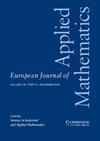Exact recovery of community detection in k-community Gaussian mixture models
IF 1.1
4区 数学
Q1 MATHEMATICS, APPLIED
引用次数: 0
Abstract
We study the community detection problem on a Gaussian mixture model, in which vertices are divided intok 个群落高斯混合物模型中群落检测的精确恢复
我们研究的是高斯混合模型上的社群检测问题,在该模型中,顶点被分为 $k\geq 2$ 个不同的社群。我们模型的主要区别在于,高斯扰动的强度对观测矩阵中的不同条目是不同的,而且我们不假设每个群落都有相同数量的顶点。我们明确找到了最大似然估计精确恢复的必要条件和充分条件,即使高斯扰动不是同分布的,也能为精确恢复提供急剧的相变;见第 7 节。应用包括超图上的群落检测。
本文章由计算机程序翻译,如有差异,请以英文原文为准。
求助全文
约1分钟内获得全文
求助全文
来源期刊
CiteScore
4.70
自引率
0.00%
发文量
31
审稿时长
>12 weeks
期刊介绍:
Since 2008 EJAM surveys have been expanded to cover Applied and Industrial Mathematics. Coverage of the journal has been strengthened in probabilistic applications, while still focusing on those areas of applied mathematics inspired by real-world applications, and at the same time fostering the development of theoretical methods with a broad range of applicability. Survey papers contain reviews of emerging areas of mathematics, either in core areas or with relevance to users in industry and other disciplines. Research papers may be in any area of applied mathematics, with special emphasis on new mathematical ideas, relevant to modelling and analysis in modern science and technology, and the development of interesting mathematical methods of wide applicability.

 求助内容:
求助内容: 应助结果提醒方式:
应助结果提醒方式:


